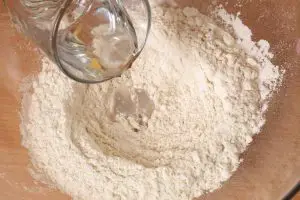In many ways, working with a bread machine can make everything easier for you when it comes to making the perfect loaf of bread. It takes much of the physical work of kneading and leaving the dough to sit out of the process, allowing you to quickly and easily produce your favorite breads within the span of a couple hours. However, just because it gets rid of some of the problems of making bread doesn’t mean that it is free of its own problems.
If you do not put in the ingredients into the bread machine properly, you are probably going to end up with bread that isn’t quite as good as it should be. The bread could be deformed or the dough may not have even made it into “bread.” In this bread troubleshooting guide, you will learn what some of the solutions to the most common bread machine problems are so that you can continue making your favorite loaves of bread.
10 Common Bread Machine Problem and Solutions
Last update on 2025-07-03 / Affiliate links / Images from Amazon Product Advertising API
1. The Dough Isn’t Rising
Naturally, dough is supposed to rise as you make it. That’s what gives bread its characteristic texture and appearance, so when you see that the dough isn’t rising in the bread machine, you may be a bit worried and confused. More often than not, this problem stems from the ingredients not being right, usually surrounding the yeast. Yeast is one of the most important aspects of getting bread to rise.
If you do not put in enough yeast, then your dough isn’t going to rise properly. Keep in mind that dough that has risen but then collapsed during the rising process (caused by too much yeast) will look very similar to dough that hasn’t risen at all. If you are unsure about a recipe, it may be worth it to watch the bread throughout the process of making it to ensure that you know where any problems occur, if any happen. If you notice that the dough hasn’t risen when it should have, then you should add some yeast and see if that fixes the problem.
2. The Dough Isn’t Mixing or Kneading Right
If you are doing some breadmaker troubleshooting and you notice that the bread machine isn’t actually kneading or mixing the dough at all, or it is doing it in a limited capacity, you might be wondering what you could have done to create such an effect. Typically, this problem lies in the machinery itself rather than the dough that you have made. Various bread machines will have different solutions to the problem, but you should check the user manual for a section about the paddles.
This is often the place where you will find ways to make sure that the paddles are working or if you need to do something about them. Sometimes just cleaning the paddles is enough to get them working; other times, you may need to do a little bit more work. Most commonly, the reason why the paddles aren’t doing their mixing and kneading is because there is food caught in them and obstructing them.
3. The Loaf Is Too Small
If you are bread machine troubleshooting and you notice that the loaf of your bread ends up being too small compared to the compartment of space allocated to make the bread, then there’s a good chance that something went wrong in the process of making it. More often than not, a loaf that is too small is a loaf that was made from dough that didn’t rise. For example, if you didn’t watch the dough while the bread was being made and you didn’t notice that the dough wasn’t rising, a loaf that is too small and probably too dense is going to be the result.
You cannot fix a loaf that has already been made. What you can do for next time is to make sure that you have all the right measurements, your yeast is fresh, and you aren’t adding too much salt or liquid, which can kill off yeast and prevent the dough from rising properly.
4. The Loaf Is Mushroom-Shaped
This problem can be considered the opposite of the problem above. A mushroom-shaped loaf is typically caused by not enough space within the pan for the loaf to shape itself properly. The reason why there isn’t enough space can range from simply not having the right sized pan for the recipe to not having the right ingredients to humid weather affecting how the loaf was made. This kind of loaf happens when it rises too fast and collapses, but not quite as severely as a fully collapsed loaf. Pay attention to all these aspects the next time that you make a loaf of bread.
5. The Loaf Collapsed on Itself
When a loaf collapses in on itself, it is almost exclusively caused by the dough rising too fast. When this happens, the dough is stretched too thin or the gasses that allow for the dough to rise are expanding so quickly that the bread cannot keep up. Like a balloon, it essentially pops, the dough covers itself, and you are left with a collapsed loaf.
Ways to solve this problem for the next time include using less yeast, ensuring proper measurements, adding some salt, checking the dough during the mixing process when you can add ingredient adjustments, and being mindful of humidity spikes.
6. The Bread Is Gummy and Sticky in Texture
If there is one thing that bread should never be, it is gummy and rubbery. Bread that has a sticky texture and is gummy in the mouth is bread that has been under baked for whatever reason. Typically, this is caused when the pan is not the right size and the heat cannot get to the center of the loaf to cook it. It can also happen when you use the wrong settings on the bread machine, such as using a light crust for a rich bread.
7. The Loaf Is Too Dense and Heavy
If you are left with a loaf of bread that is more akin to a brick than to something you would actually eat, then there’s a good chance that the ingredients you were using got mixed up somewhere along the way. What this means is that you probably used either too much or too little of an essential ingredient. There are enough of these ingredients that can affect your loaf that it can be hard to tell which one was the culprit. Next time you make bread, be mindful of how much water, salt, yeast, sugar, flour, and added ingredients (fruits, chocolate chips, etc.) you used so that you can get the measurements right.
8. The Loaf Has Large Pockets of Air
While airy and light loaves are favored in some circumstances, it can make for a problem if you wanted a slice of toast or some sandwich bread. This kind of problem tends to occur when the bread rose too much, but not enough for it to collapse entirely. When this happens, you should try to cut down on the ingredients that allow for the dough to rise too fast, notably yeast and salt.
9. The Crust Is Burnt
If the crust ends up getting burnt in the bread machine, then there’s a very good chance that you may not have gotten the crust setting right on the machinery itself. If you were aiming for a light crust and you made your bread according to that light crust recipe, but you accidentally set the bread machine to make a dark crust, you may be left with burnt crust. Be mindful of the settings you have put your bread maker on.
10. The Bread Tastes Rancid
Freshly baked bread should never taste rancid. There are a few reasons why a loaf that is fresh out of the bread machine tastes as if it has been sitting for several days. For one, it could be that there are bits of food stuck to the paddles and they were cooked into the bread. It could be that the ingredients you used were already rancid, especially oil, eggs, and milk. If you had the machine set on a delayed start and you had fresh eggs, milk, and other perishables in the machine, these could have gone bad in the hours it takes for the delayed start to begin. Chances are that if a fresh loaf is rancid, some of the ingredients that you used were already rancid to begin with.









